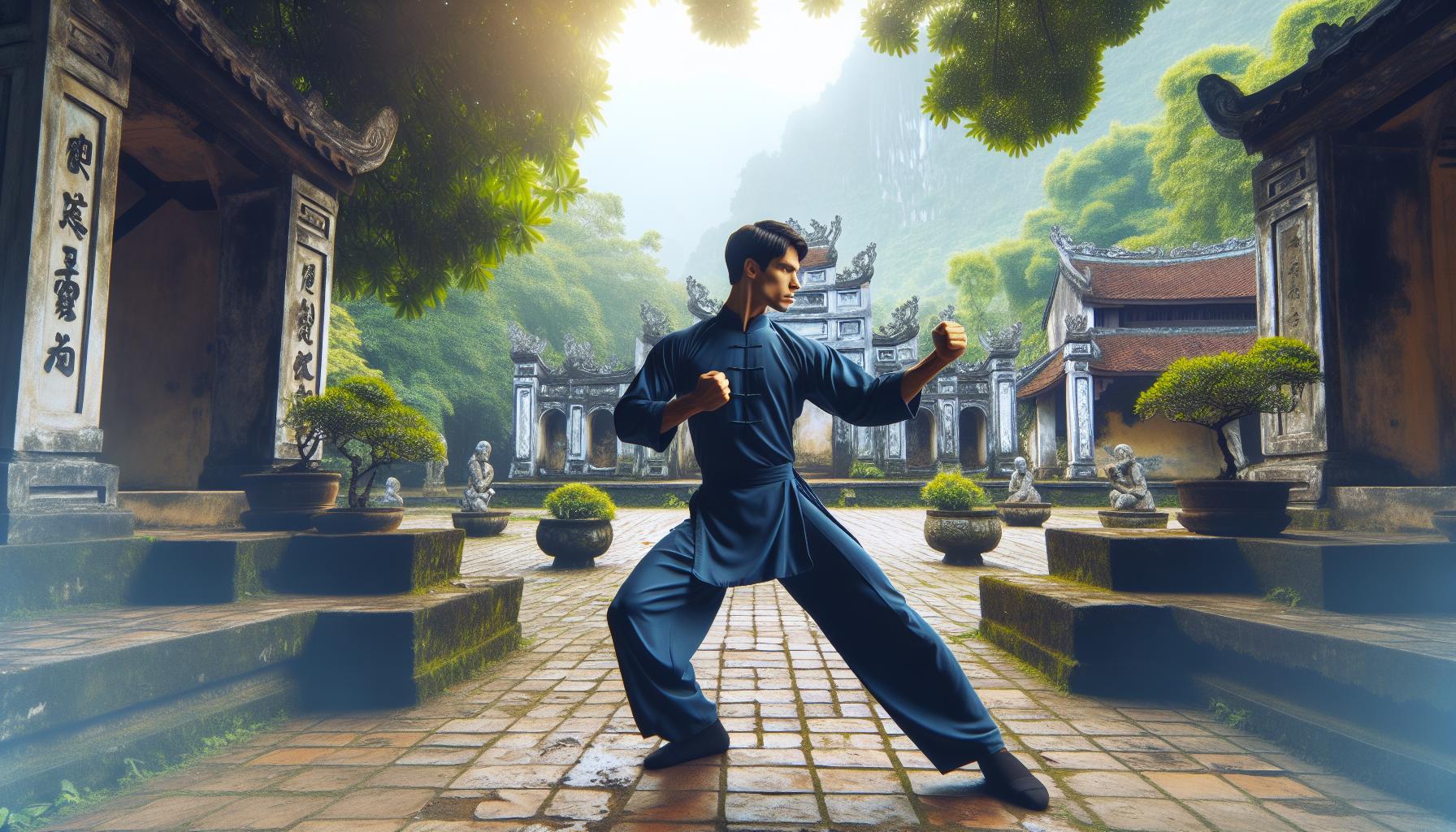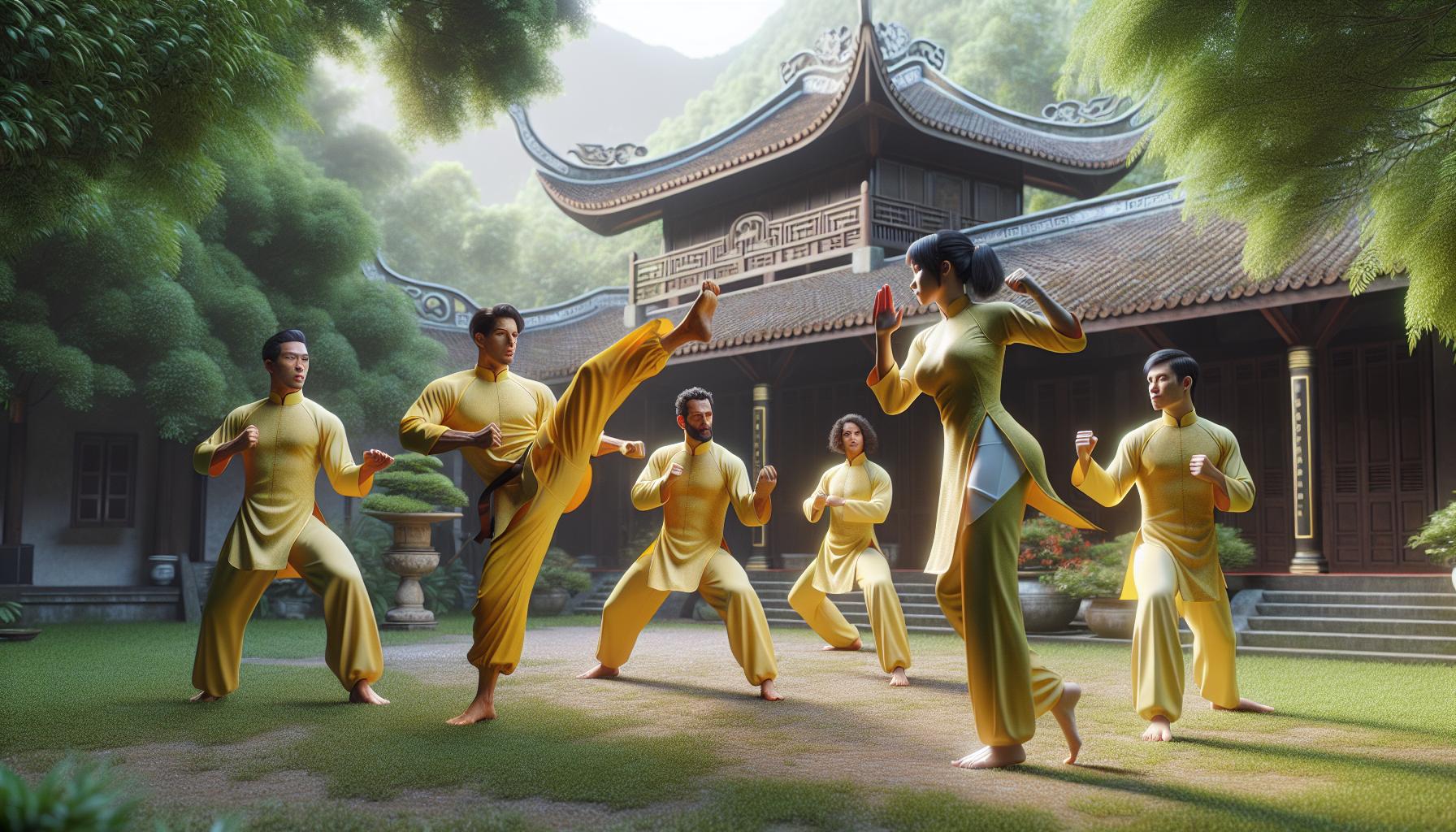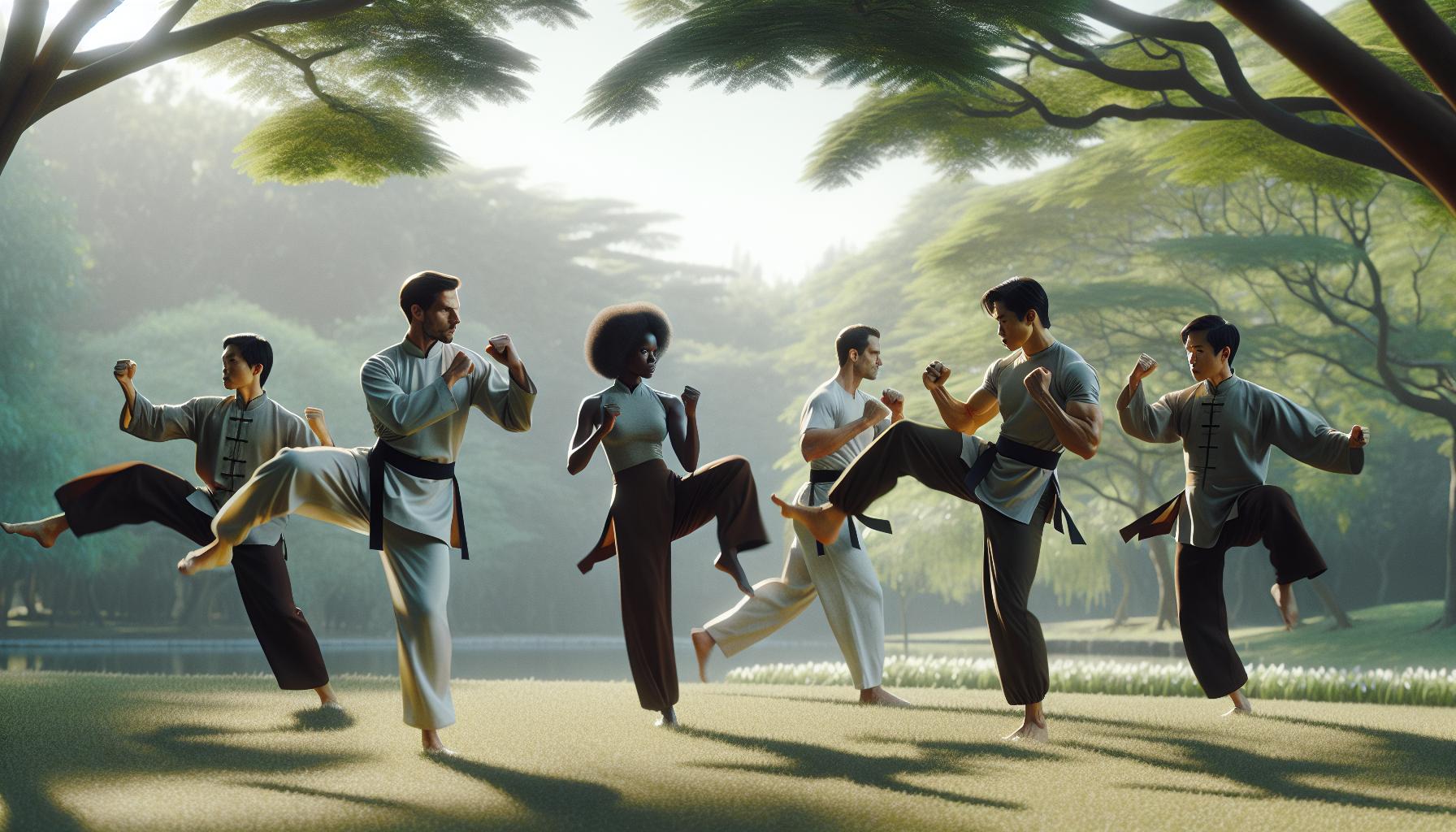
Discover the Rich History and Techniques of Vietnam Martial Arts: Vovinam and More
Vietnamese martial arts have a rich and diverse history that captivates practitioners and enthusiasts alike. With roots that stretch back centuries, these arts blend combat techniques with cultural traditions, offering a unique glimpse into Vietnam’s heritage. I’ve always been fascinated by how these martial styles not only focus on physical prowess but also emphasize discipline, respect, and mental fortitude.
From the graceful movements of Vovinam to the striking techniques of Bình Định, each style tells a story of resilience and skill. As I delve deeper into the world of Vietnamese martial arts, I discover not just effective self-defense methods but also a path to personal growth and community connection. Join me as we explore the captivating realm of Vietnam’s martial arts, where tradition meets modern-day practice.
Key Takeaways
- Diverse History: Vietnamese martial arts showcase a rich history influenced by various cultures, evolving over centuries to blend combat techniques with cultural traditions.
- Key Styles: Major styles such as Vovinam and Bình Định emphasize different techniques and philosophies, with Vovinam focusing on self-defense and mental strength, while Bình Định integrates weapons training and fluid movements.
- Cultural Significance: These martial arts are vital for fostering discipline, respect, and community connections, serving as tools for personal growth and resilience.
- Training Practices: Training typically involves rigorous physical conditioning, technique drills, and sparring, combining traditional methods with modern practices to enhance combat effectiveness and mental fortitude.
- Global Recognition: Vietnamese martial arts are gaining international popularity, with styles like Vovinam attracting practitioners worldwide, contributing to competitions and promoting Vietnamese culture globally.
- Holistic Benefits: The integration of mindfulness and personal development principles makes these martial arts appealing to a broad audience, blending physical skills with mental and spiritual growth.
Overview of Vietnam Martial Arts
Vietnam martial arts encompass a wide range of fighting styles, each with its own unique characteristics and philosophies. These practices blend practical self-defense techniques with cultural traditions, reflecting Vietnam’s rich historical landscape.
Key Styles
- Vovinam
Vovinam emphasizes self-defense, featuring high kicks, throws, and joint locks. This style incorporates the philosophy of harmony and balance, aiming to cultivate both physical and mental strength. - Bình Định
Bình Định boasts a deep-rooted history, characterized by its integration of weapons and open-hand techniques. The style highlights fluid movements and powerful strikes, often practiced in performance forms known as “hình.” - Karate and Taekwondo
I notice that Karate and Taekwondo have influenced many Vietnamese martial arts, particularly in their approach to technique and competition. These styles often coexist within local training environments, enriching the martial arts community. - Other Traditional Styles
Additional styles, such as Thiếu Lâm and Hình Ý, focus on unique concepts of combat. Each emphasizes the importance of discipline and respect, essential values in martial arts training.
Cultural Significance
Vietnam martial arts play a vital role in fostering discipline, respect, and community connection. They serve as tools for self-improvement and personal growth, allowing practitioners to build resilience. Training often occurs in communal settings, reinforcing social bonds among students while celebrating shared heritage.
Training Methods
Practicing Vietnam martial arts typically involves rigorous physical conditioning, technique drills, and sparring sessions. Styles vary in their training methods, with some focused on traditional forms and others emphasizing free sparring. This variety allows practitioners to tailor their training to personal goals.
Global Influence
Vietnam martial arts are gaining recognition worldwide, contributing to various international competitions. Their blend of effective combat techniques and cultural heritage appeals to many learners. This growing interest promotes deeper understanding and appreciation of Vietnamese culture through the lens of martial arts.
Historical Background

Vietnamese martial arts reflect a deep historical tapestry influenced by various ancient cultures and evolved through distinct periods.
Influence of Ancient Cultures
Ancient Vietnamese history is marked by interactions with Chinese, Indian, and indigenous cultures. Chinese martial arts profoundly impacted Vietnam, particularly during the first millennium AD when Vietnam was under Chinese rule. Techniques and philosophies, such as Tai Chi and Kung Fu, were integrated into local practices. Indian influences, introduced through trade and the spread of Buddhism, also contributed to the development of spiritual aspects within martial arts. Indigenous fighting styles, rooted in tribal traditions, fostered resilience, focusing on practical self-defense. These early influences combined to create a unique framework that emphasizes not only physical prowess but also the mental and spiritual dimensions of martial arts.
Evolution Through Time
The evolution of Vietnamese martial arts spans centuries, adapting to social changes and foreign incursions. During the Tran Dynasty (13th century), martial arts were formalized into military training, emphasizing discipline and tactical expertise. The 20th century marked significant transformation, with the emergence of styles like Vovinam, founded in 1938 by Nguyễn Lộc, merging traditional techniques with contemporary self-defense methods. The Vietnam War further fueled the evolution, as martial arts served both as a means of combat training and a cultural expression amidst turmoil. Today, these martial arts continue to evolve, blending traditional techniques with modern practices while maintaining the core values of respect, discipline, and community.
Key Styles of Vietnam Martial Arts

Vietnamese martial arts showcase various styles that highlight unique techniques and philosophies. Among them, Vovinam and Bình Định stand out, each with distinct characteristics that reflect their historical and cultural significance.
Vovinam
Vovinam emphasizes self-defense while incorporating high kicks, joint locks, and throws. Founded in 1938 by Nguyễn Lộc, this style integrates both armed and unarmed techniques, promoting adaptability in chaotic situations. Vovinam practitioners often train with a strong focus on physical conditioning, agility, and mental discipline. The practice involves traditional uniforms, known as áo vàng, which symbolize unity and discipline. Its global outreach continues, with numerous schools worldwide, promoting Vietnamese martial arts culture through competitions and exhibitions.
Bình Định
Bình Định, rooted in the central region of Vietnam, combines powerful strikes with fluid movements. This style features both empty-hand techniques and weapons training, including the staff and sword. Originating from the Bình Định Province during the 16th century, it reflects Vietnamese historical battles and the resilience of warriors. Practitioners develop coordination, strength, and tactical thinking while honing skills through rhythmic forms called “võ thuật.” The style’s emphasis on traditional weapons showcases Vietnam’s rich martial heritage, contributing to its lasting appeal.
Thiền
Thiền focuses on the meditative aspect of martial arts, blending physical techniques with spiritual development. This style draws from Buddhist teachings and encourages practitioners to cultivate inner peace and mindfulness. Through breathing exercises and meditation, practitioners enhance focus and clarity, establishing a deeper connection between mind and body. Thiền serves not only as a martial art but also as a spiritual practice, nurturing holistic well-being and personal growth. Its integration of mindfulness principles positions it uniquely within the landscape of Vietnamese martial arts, attracting interest from those valuing both physical and mental training.
Techniques and Training Practices

Vietnamese martial arts encompass a variety of techniques and training practices that emphasize physical skills, mental discipline, and cultural heritage.
Basic Techniques
Basic techniques form the foundation of Vietnamese martial arts, incorporating striking, grappling, and self-defense methods. Key techniques include:
- Kicks: High-level kicks demonstrate agility and precision, common in styles like Vovinam. Front kicks, side kicks, and spinning kicks often showcase flexibility and power.
- Punches: Straight punches, hooks, and uppercuts focus on generating force from the core. These punches enhance hand-eye coordination and timing during sparring.
- Joint Locks: Joint locks, crucial for self-defense, immobilize an opponent. Practitioners learn to apply pressure on joints, allowing for effective control without excessive force.
- Throws: Throws incorporate leverage and balance to unbalance an opponent. Techniques often require understanding weight distribution and body movements to execute effectively.
These basic techniques provide a structured approach for practitioners of all levels, enhancing their combat effectiveness and self-confidence.
Traditional Training Methods
Traditional training methods remain integral to the learning process in Vietnamese martial arts. These methods include:
- Drilling Basics: Repetitive drills for basic techniques ensure mastery. Practitioners spend hours perfecting kicks, punches, and stances to build muscle memory.
- Partner Work: Engaging in partner drills allows for real-time application of techniques. This practice fosters adaptability and promotes understanding of timing and distance.
- Forms Training (Bài): Specific patterns, or forms, consist of sequences that combine techniques. Practicing forms enhances focus, discipline, and deeper appreciation for martial arts philosophy.
- Meditation: Incorporating meditation helps calm the mind and improves concentration. Practitioners often engage in mindful breathing and visualization to enhance their mental resilience.
- Sparring: Controlled sparring sessions aid in applying techniques under pressure. Sparring sharpens reflexes, strategies, and situational awareness during combat situations.
Traditional training methods foster a holistic learning environment that emphasizes physical skills, mental fortitude, and cultural connection.
Modern Impact and Popularity
Vietnamese martial arts have gained significant popularity worldwide, influencing various aspects of global martial arts culture. Practitioners across different countries now embrace styles like Vovinam, which emphasizes practicality and adaptability in self-defense scenarios. Schools in regions such as Europe, North America, and Asia offer classes, catering to diverse communities interested in martial arts training.
Vovinam’s growth can be attributed to its comprehensive approach, incorporating psychological and physical elements that promote personal development. The universal appeal of its high kicks, throws, and joint locks attracts individuals seeking both fitness and self-defense skills. This style encourages participation in international competitions, showcasing not only technical prowess but also Vietnamese culture on a global stage.
Bình Định continues to thrive as well, with its rich historical roots adding to its allure. Event organizers often highlight traditional exhibitions and seminars, drawing attention to its unique techniques and weapons training. These events celebrate the art’s cultural heritage and inspire new generations to delve deeper into Vietnamese martial arts.
Furthermore, the fusion of martial arts and wellness practices enhances their popularity. Many practitioners incorporate Tai Chi elements, focusing on movement meditation and stress relief. This holistic approach appeals to individuals searching for balance in their lives, attracting people from various backgrounds and ages. The meditative aspects of styles like Thiền contribute to this trend by emphasizing mindfulness and personal growth.
Social media plays a crucial role in promoting Vietnamese martial arts. Online platforms allow schools to share training videos, success stories, and cultural insights, reaching audiences far beyond their local communities. Instructional content and tips on techniques help beginners quickly engage with these martial arts from the comfort of their homes.
Overall, the modern impact and popularity of Vietnamese martial arts form a vibrant tapestry that reflects cultural richness and fosters global connections. Their incorporation into fitness, mental well-being, and community bonding exemplifies their lasting significance in today’s martial arts landscape.
Conclusion
Vietnamese martial arts offer a profound journey into a world of discipline and cultural richness. Each style I’ve explored reveals unique techniques and philosophies that foster personal growth and community bonds.
As I delve deeper into practices like Vovinam and Bình Định, I see how they not only strengthen the body but also cultivate mental resilience. The global embrace of these arts showcases their adaptability and relevance in today’s fast-paced world.
By participating in these martial arts, I’m not just learning self-defense; I’m connecting with a vibrant heritage that emphasizes respect and mindfulness. The journey through Vietnamese martial arts is truly a path of discovery that enriches my life and connects me with others around the globe.



